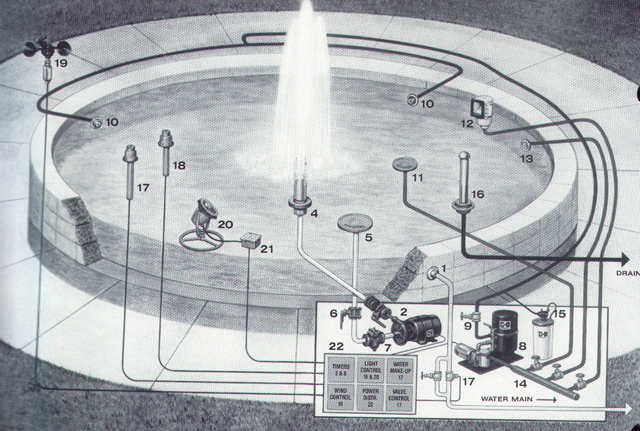Large Fountain Design Layout
Large fountains make a statement of elegance and beauty to any location and can be an investment that can increase a building’s resale value. As you may have guessed there is much more than meets the eye with large fountains as there are a variety of components that help it look amazing and run as intended. If you are in need of assistance in designing or laying out a fountain, turn to the professionals at Fountain Gallery . For over 30 years we’ve been helping homeowners, engineers and architects create beautiful fountain designs to display on their properties.
If you’re ready to start designing and building a fountain, give us a call at+880 1712-150377or fill out our simple contact form. We can’t wait to make your fountain visions become a reality!
Large Fountain Components & Layout Example
The diagram below illustrates the various circuits and components commonly used in a large fountain, including a centrifugal flooded end pump, a filtration and water treatment system, various sensors, underwater lighting and electrical controls.

Pump Section: Water is supplied to the pool via a main line and inlet (1), which is controlled by a gate valve for initial filling of the pool. A centrifugal end pump (2) re circulates water through a butterfly valve (3) for adjustment and a jet (4). Water from the jet is contained in the pool and returned to the pump via an anti-vortex plate (5), butterfly isolation valve (6), and strainer (7), for removal of coarse material and protection of the pump.
Filter Section: Water is filtered by a sand filter (8), which includes a self-priming pump independent from the main fountain group. Water is returned through a gate isolation valve (9) through adjustable inlets (10), which can be directed to create turbulence in desired areas. Water is returned to the filters via an anti-vortex plate (11), surface skimmer (12), and a vacuum fitting (13); which are connected to a manifold (14). These lines each have isolation gate valves. The manifold is connected to the strainer on a small self-priming pump which recirculates the water from the pool through the filter. Chemical addition is accomplished by use of a small metering pump (15) and tank to supply hypochlorite solution. An overflow drain (16) is set to eliminate rainwater, etc., to prevent overflow. The upper section can be unscrewed to completely drain the pool.
Electrical Control Section: An electric water makeup control replaces water lost to evaporation, splashing, etc. This sensor and control actuate a solenoid valve (17) on the main water line to maintain water level and cuts off electrical power to lighting fixtures if they are not immersed. A wind control (19) monitors wind conditions and can shut down or reduce the flow to the jet at preset wind conditions. The underwater lighting fixture (20) is a base mounted unit connected to an underwater junction box (21) by underwater cable. The junction box is conduit-connected to the control box, and completely potted to prevent leakage. The light is controlled by a timer or sequencer. The main control box (22) houses the timers, light controls, water makeup and wind controls. In addition, it is the center for power distribution to various components and contains circuit breakers, fuses, motor starters, etc